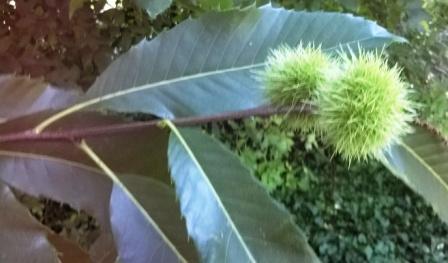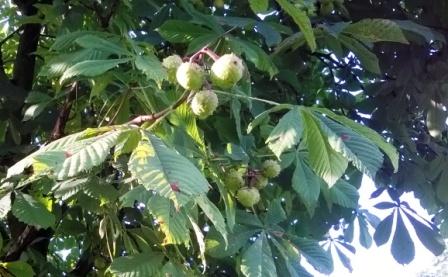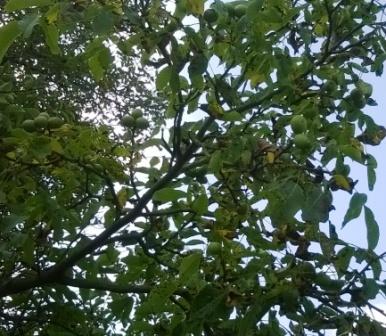Botanically a nut is a single achene. An achene is a dry fruit with one seed (sometimes two), and a hard rocky- or woody shell (the pericarp). Examples of genuine nuts: chestnut, beech nut, acorn, hazelnut.
Other fruits and seeds that are also called "nuts" are: almond ((nut), the seed of a drupe), betel nut (seed of a drupe), cashew nut (core of the seed), pistachio (seed), coconut (drupe), brazil nut (seed Bertholletia excelsa), pecan (seed), peanut (legume, grain), walnut (not a botanical nut: the shell is not singular).
If you are going to pick nuts, use your feet. With thin soles you feel exactly where notes lay, even if you cannot see them under grass and leaves.
Chestnuts are by 3 in a spiny hedgehog -like husk. Use only the strong feeling thick chestnuts to store. Sometimes there are none, often one, sometimes two, rarely three good in a husk. The floppy copies can still fine to the piggy bank. At this time of the year they have a few days or at most weeks to convert harvest surpluses into fat and meat. Put chestnuts a day in water to float out or drown worms .
Let nuts and chestnuts dry before you store them, otherwise they become moldy. Go regularly pick up again. There are always rivals in the field: mice, squirrels, people... You can pop chestnuts (on the stove, possibly cut a cross in the bark), cook, puree it, or grind and mix with other flour into dough to bake bread.
Difference chestnut horse chestnut
 The sweet chestnut has elongated and toothed leaves. The flowers are long (10-17 cm), erected catkin that bloom in summer. The husks usually has three fruits. The middle is the thickest, and the other two bend around it. At the points are the characteristic tufts that are the remains of the catkin.
The sweet chestnut has elongated and toothed leaves. The flowers are long (10-17 cm), erected catkin that bloom in summer. The husks usually has three fruits. The middle is the thickest, and the other two bend around it. At the points are the characteristic tufts that are the remains of the catkin.
The husk of the chestnut has more thinner and longer spines than the horse chestnut.
 The horse chestnut has large leaves having from five to seven parts such as fingers on a hand.
The horse chestnut has large leaves having from five to seven parts such as fingers on a hand.
The inflorescence has like a candle upright, white plumes with dozens of flowers.
The horse chestnut does not have a plume on the top, is rounder and more shiny. She is not edible, bitter and slightly toxic.
You can break horse chestnuts, and soak a few hours in water, and you've ready suds.
The White Horse chestnut (Aesculus hippocastanum) is part of the horse chestnut family (Hippocastanaceae) and Sweet Chestnut (Castanea sativa) in the beech family (Fagaceae). The red horse chestnut (Aesculus carnea) is a cross between the white horse chestnut (Aesculus hippocastanum) and the red buckeye (Aesculus pavia).
Chestnut puree
Using a sharp knife, make a cross-shaped incision on the tip of the sweet chestnuts. Cook for 5 to 10 minutes in water. Peel them hot. Let them simmer for 45 minutes (in milk). Drain to puree. Mix the puree with some boiling milk, cream and butter.
You can sweeten with honey or syrup, or spicy herbs, or salt it. There are an infinite number of variations and finishes possible.
Flour of acorns:
Acorns contain 6 percent protein and about 65 percent starch and lots of bitter tannins. That can be pulled out in order to make them edible.
§ Make a cut on the acorns and cook a few minutes to ease peeling
§ peel them and chop them into smaller pieces.
§ Cook them and change the water regularly, until the water runs clear.
§ Strain them and grind them
This puree can be used directly or if you let it dry thoroughly, ground into flour. Acorn flour does not contain gluten.
You can make acorn porridge, acorn puree and acorn bread (actually rather wafers, such as hamburgers) with it. Whether or not mixed with other flours (e.g. also chestnut flour).
Dotorimuk is a Korean acorn jelly, which is usually used as a side dish with vegetables and herbs. The acorn inside is ground, and as pasta soaked to remove tannins; stirred and sieved. The water is poured off the sediment and regularly refreshed. The starchy mass is dried later in bowls and pulverized.
Seed is the small embryonic starter of life covered by the seed coat.
A pit is one hard protection around the seed in the interior of some pome fruit.
Kernel: softer inner of seed or nut, the actual seed in the pit.
In stone fruit is also spoken of a pit, but this is botanically wrong.
Cereal is a collective name for monocot crops from the family of grasses.
Grain: fruit of a cereal grass, used as food.
Bean is a common name for various edible seeds of a legume.
To these pulses the peas also belong.
Walnuts contain more than 50% oil. There are about 100 nuts in a kilo. From 5 kg you get 2 kg of peeled walnuts. Of this you press about 1 liter of walnut oil.
If the divider breaks with a 'snap' the nuts are dried sufficiently. Select the nuts from the shell, don’t use them it they have signs of fungal spores, they spoil your oil. The highest yield you'll get by warming the shelled nuts at 60 ° C and pressing at 200 to 300 bar.
The remaining cake may be dried and ground to process into pastry. Unless there are pieces of wood in it, then it becomes fodder.
Cracking nuts: Ever since my nutcracker cracked on an almond, I've been using a pipe wrench. I now notice that I used to do it wrong. I now put the nut upright in the pliers, teeth (north-south) transverse to the seam (east-west). The nuts usually come out in fewer pieces. Often even in one whole, sometimes 2,3,4. But less tinkering to extract pieces of 'brain' from the 'skull'. You also have more control over what you do, dose your strength better and crack the shell without breaking or crushing the core. Often you can simply peel the bowl off the core in 4 wedges.
Nut picker
A from tough and flexible wire made rugby ball-shaped basket, rotatably attached to a long handle. You roll this 'egg' on the ground. For harder objects the bars will open easily, so they enter the hive.
Also useful for chestnuts, apples, hazelnuts and acorns.
Walnut
 The genus Juglans has about 21 species. And subspecies and hybrids. The marrow of their twigs is ladder shaped.
The genus Juglans has about 21 species. And subspecies and hybrids. The marrow of their twigs is ladder shaped.
The nut trees provide valuable and beautiful wood for furniture, rifle butts, aircraft propellers, dashboards etc.
The most common and widely used species in the low countries is the Juglans regia. Which is considered native, and origins from southern Europe across the Balkans to Central Asia. Especially the Romans led to its spread. The tree can be up to 30 m high and over 10 m wide. He gets a gray trunk with deeply furrowed bark.
The leaf consists of 2 to 6 pairs of leaves with a terminal leaflet. They are made uneven feathered.
The green husk has white dots.
The nut is smaller and more pointed than the black below.
The designation wal (nut) refers to tribes in the south, where the nut came from. They gave their name to the Walloons, Wallonia and Wales.
Of black walnut or black nut, Juglans nigra, the name already indicates that the bark and walnut color are dark. The tree is native to eastern North America, Canada and Southeast Texas. In Europe, he was (little) used as a park and avenue tree, and as a rootstock for other varieties.
While the shells of our European walnut easily rot, the black and round balls of Juglans nigra stay longer hard. To crack the super strong shell of American walnut, use a vise. Which is powerful enough, and won’t smash -in contrast to a sharp hammer blow- the content immediately to crushed flakes.
He (J. nigra) is up to 40 m high. The light brown bark is dark gray with deep, reticular grooves.
The bright green, glossy odd-pinnate leaves consist of at least six couples who are 7-10 cm long and 2-3 cm wide and some are lanceolate with finely serrated edge and fine white-haired bottom. The terminal leaflet is very small or missing.
The yellow-green, round husk is 4-5 cm tall and dark brown. The 3-4 centimeters nut has deep grooves and hardly comes out the hard husk.
She is darker, rounder and harder than our walnut. The four -part core would be less grooved.
Yields are low.
Walnut trees (family Juglandaceae) produce as a protective substance a herbicide (plant pesticide product) Juglone, which is also used as a colorant for textiles and ink, in foodprocessing and cosmetics (hair dye).
Juglone is found in the leaves (less), bolsters (2-4%), roots and bark of this family. This anti-growth agent is a respiratory inhibitor for (some) plants. The aromatic compound with the gross formula C₁₀H₆O₃. It ensures clogged xylem vessels and tissues. In nature or (1 year) in compost heap it can digest quite easily, but you better avoid it in the (vegetable) garden.
In South America, some tribes used the cytotoxic properties to fish by throwing shredded bolsters into the water.
Young walnut trees do not appear to cause toxic reactions in susceptible plants until they are seven to eight years old. Juglone of decomposing black walnut roots can remain in the ground for more than a year after harvesting and removal over the entire surface of the outer dome of the crown.
Plants that are tolerant of Juglone and still thrive are e.g. beans, beets, melons, carrots, onions, parsnip,
peaches, nectarines, cherry plums, pears, black raspberries, ..
Plants that are sensitive to Juglone include tomatoes, rhubarb, cucumbers, eggplant, potatoes, peppers, alfalfa, asparagus and cabbage, blueberries, blackberries, grapes, different types of pears, etc.
Around 1500 years ago the wise Sessa ebn Daher from India invented chess and taught it to King Shirham. Who was so excited (about the necessary cooperation between the peasants and soldiers (pawns) and the nobility (the chessmen) that he made Sessa choose a reward. Sessa asked the hand of his daughter, but was asked to choose something else.
Sessa asked than one grain (of rice) on the first square of the chess field, two grains on the second square, four grains on the third, etc. In each field, so always double the previous field.
The king first felt insulted about this modest gift. That changed when the accountants at the court went to work. It was more than 18 trillion (2 ^ 64-1) seeds, much more than the entire world production together.
Suppose there are 50 grains in a cubic centimeter. Then we get a mountain of more than 3 * 10 ^ 17 cubic centimeters, or three hundred billion cubic meters of rice. Enough to cover Belgium and the Netherlands with a one meter thick layer of rice.
